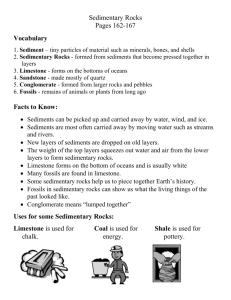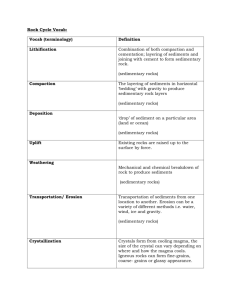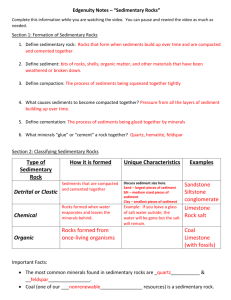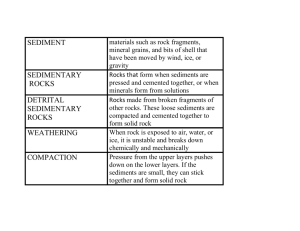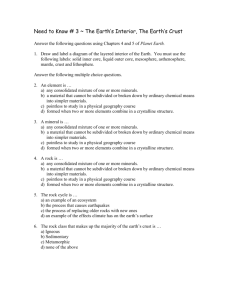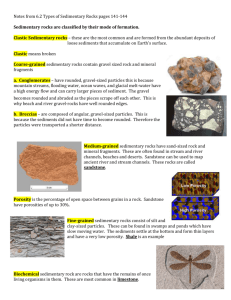Sedimentary Rocks
advertisement
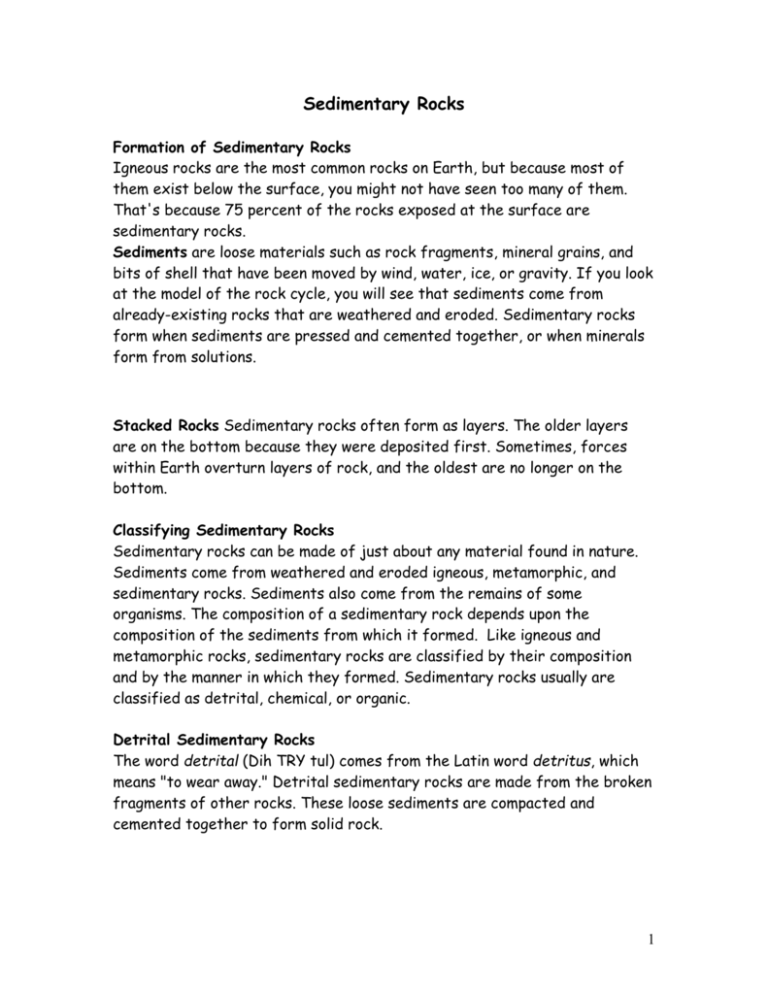
Sedimentary Rocks Formation of Sedimentary Rocks Igneous rocks are the most common rocks on Earth, but because most of them exist below the surface, you might not have seen too many of them. That's because 75 percent of the rocks exposed at the surface are sedimentary rocks. Sediments are loose materials such as rock fragments, mineral grains, and bits of shell that have been moved by wind, water, ice, or gravity. If you look at the model of the rock cycle, you will see that sediments come from already-existing rocks that are weathered and eroded. Sedimentary rocks form when sediments are pressed and cemented together, or when minerals form from solutions. Stacked Rocks Sedimentary rocks often form as layers. The older layers are on the bottom because they were deposited first. Sometimes, forces within Earth overturn layers of rock, and the oldest are no longer on the bottom. Classifying Sedimentary Rocks Sedimentary rocks can be made of just about any material found in nature. Sediments come from weathered and eroded igneous, metamorphic, and sedimentary rocks. Sediments also come from the remains of some organisms. The composition of a sedimentary rock depends upon the composition of the sediments from which it formed. Like igneous and metamorphic rocks, sedimentary rocks are classified by their composition and by the manner in which they formed. Sedimentary rocks usually are classified as detrital, chemical, or organic. Detrital Sedimentary Rocks The word detrital (Dih TRY tul) comes from the Latin word detritus, which means "to wear away." Detrital sedimentary rocks are made from the broken fragments of other rocks. These loose sediments are compacted and cemented together to form solid rock. 1 Weathering and Erosion When rock is exposed to air, water, or ice, it is unstable and breaks down chemically and mechanically. This process, which breaks rocks into smaller pieces, is called weathering. Compaction Erosion moves sediments to a new location, where they then are deposited. Here, layer upon layer of sediment builds up. Pressure from the upper layers pushes down on the lower layers. If the sediments are small, they can stick together and form solid rock. This process is called compaction. Cementation If sediments are large, like sand and pebbles, pressure alone can't make them stick together. Large sediments have to be cemented together. Cementation occurs when water soaks through soil and rock. As water moves through soil and rock, it picks up atoms and molecules released from minerals during weathering. The resulting solution of water and dissolved materials moves through open spaces between sediments. Minerals such as quartz, calcite, hematite, and limonite are deposited between the pieces of sediment. These minerals, acting as natural cements, hold the sediment together like glue, making a detrital sedimentary rock. Shape and Size of Sediments Detrital rocks have granular textures much like granulated sugar. They are named according to the shapes and sizes of the sediments that form them. For example, conglomerate and breccia both form from large sediments. If the sediments are rounded, the rock is called conglomerate. If the sediments have sharp angles, the rock is called breccia. The roundness of sediment particles depends on how far they have been moved by wind or water. Materials Found in Sedimentary Rocks The gravel-sized sediments in conglomerate and breccia can consist of any type of rock or mineral. Often, they are composed of chunks of the minerals quartz and feldspar. They also can be pieces of rocks such as gneiss, granite, or limestone. The cement that holds the sediments together usually is made of quartz or calcite. Sandstone is formed from smaller particles than conglomerates and breccias. Its sand-sized sediments can be just about any mineral, but they are usually grains of the minerals quartz and feldspar that are compacted and cemented together. Siltstone is similar to sandstone except it is made 2 of smaller, silt-sized particles. Shale is a detrital sedimentary rock that is made mainly of clay-sized particles. Clay-sized sediments are compacted together by pressure from overlying layers. Organic Sedimentary Rocks Rocks made of the remains of once-living things are called organic sedimentary rocks. One of the most common organic sedimentary rocks is fossil-rich limestone. Like chemical limestone, fossil-rich limestone is made of the mineral calcite (CaCO3). However, fossil-rich limestone mostly contains remains of once-living ocean organisms instead of only calcite that has come out of ocean water. Animals such as mussels, clams, corals, and snails make their shells from CaCO3 that eventually becomes calcite. When they die, their shells accumulate on the ocean floor. When these shells are cemented together, fossil-rich limestone forms. If a rock is made completely of shell fragments that you can see, the rock is called coquina (koh KEE nuh). Chalk Chalk is another organic sedimentary rock that is made of microscopic shells. When you write with naturally occurring chalk, you're crushing and smearing the calcite-shell remains of once-living ocean organisms. Coal Another useful organic sedimentary rock is coal. Coal forms when pieces of dead plants are buried under other sediments in swamps. These plant materials are chemically changed by microorganisms. The resulting sediments are compacted over millions of years to form coal, an important source of energy. Much of the coal in North America and Europe formed during a period of geologic time that is so named because of this important reason. 3




